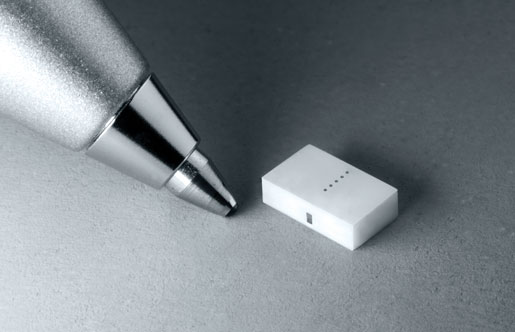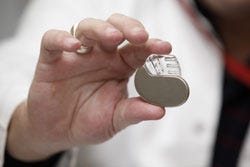The miniaturization of medical devices should go hand-in-hand with an expansion of performance and capabilities.
February 1, 2016

The miniaturization of medical devices should go hand-in-hand with an expansion of performance and capabilities.
Jens Troetzschel
A rectangular medical component from Heraeus CerMet Composites demonstrates the potential for dramatic miniaturization.
I recently came across a TV documentary on the evolution of the music record industry. Some of us remember buying long-playing (LP) albums at the neighborhood record store. But over the course of a few decades, the industry experienced an unprecedented period of innovation: the bulky LP transformed into smaller, more convenient formats, like eight-track and cassette tapes.
The introduction of the compact disc (CD) was the next step in the industry’s evolution to miniaturize. Of course, it was inevitable that we would go “all digital” and eliminate the need for physical music altogether.
When people talk about this disruptive technology, they focus on the physical perspective, noting that a large, cumbersome record album could now exist as an invisible digital file. But to me, the “miniaturization” of music was not driven by the size factor alone. If you look at every point in its evolution journey, while music formats were shrinking, the capabilities of these new formats were expanding.
The same thinking should apply when looking at the state of miniaturization in medical devices. While it is crucial that the industry make devices to minimize the “invasive” effect on the patient, the greater goal has to focus on performance: making the device more reliable, raising the quality of treatment, and producing better outcomes for the patient.
|
Better performance, safety, and reliability should be part of the medtech miniaturization trend. |
It is an exciting time to work in medical technology. As an industry, we have seen an unprecedented era of innovation. Micro-surgery and treatment that is truly minimally invasive are becoming options for more and more patients thanks to the work of the medical technology industry. But smaller is not better if we remain content making a device smaller and lighter; enhancing its performance and functionality has to be equally important.
Over the past several years, we have conducted extensive research on designing a solution that combines both. Our work with CerMet composites has shown that existing technology, which was a bulky wire base header-connector with 60-plus manually assembled components, could be replaced by one integrated part. CerMet could provide device manufacturers with virtually unlimited channels for sensing and stimulation. Again, performance and functionality are not taking a back seat to the miniaturization. A higher channel count means a higher integrational density and resolution, thus enabling smaller, more advanced devices. Performance should drive miniaturization, not the other way around.
Safety is another critical factor. Reducing individual parts is an important part of the safety equation. The CerMet technology was designed so one does not assemble pins into a ceramic. Instead, we created one, monolithic composite component with the conductive channels already integrated. Fewer parts means fewer sources for failure. Higher component reliability will render the whole therapy safer for the patient.
Another major trend in miniaturization will be the role of materials science. The therapy bar is continually raised, meaning devices have to perform better as they are made smaller. One question all device engineers need to ask is: what is the right material? Implants have to perform reliably and with longevity under demanding conditions for decades.
|
Heraeus CerMet technology can be used in miniaturized medical implants. |
Heraeus’ expertise in materials science was invaluable with CerMet. We were able to utilize two inherently different materials classes (metals and ceramics) that leveraged their specific strengths, conductive and ductile platinum with insulating and hard ceramic. The composite material turned out to be notably stronger than the pure ceramic as demonstrated in three-point bending tests.
The evolution of device miniaturization will continue; but the most successful innovators and market leaders will follow these trends and guiding principles:
Going small is not enough. If your device miniaturization strategy is based solely on making your device smaller, you’re not changing the market, only your manufacturing processes. Safety, performance, reliability, and improved functionality have to be your driving factors.
Miniaturizing without optimizing is a wasted opportunity. Materials science will play a major role influencing the performance, reliability, and safety of miniaturized devices. Materials experts should be part of every innovation and improvement discussion.
Sophistication through simplification. Look at the success of Apple under the leadership of Steve Jobs. He was relentless in pushing his engineers and developers to look for ways to make Apple products simpler to provide a better consumer experience. That philosophy of simplicity enabled innovations like the iPhone to have unprecedented power and functionality. That same mindset can work in the medical device industry to drive a new wave of innovation.
Decades ago, the only way to listen to recorded music was a record player and stereo system to play your LPs. Today, you can listen on your smart phone or a tiny mp3 player. The value in the innovations is not just the reduced size, it’s the increased performance, convenience, and listening experience it provides. Success in miniaturizing medical devices requires the same type of “big thinking.”
Heraeus Medical Components will be exhibiting at the world's largest medical design and manufacturing event, the MD&M West Conference, February 9-11, 2016. |
Jens Troetzschel leads New Developments and Future Technologies for Heraeus Medical Components. Contact him at [email protected].
[Images courtesy of HERAEUS MEDICAL COMPONENTS]
You May Also Like




